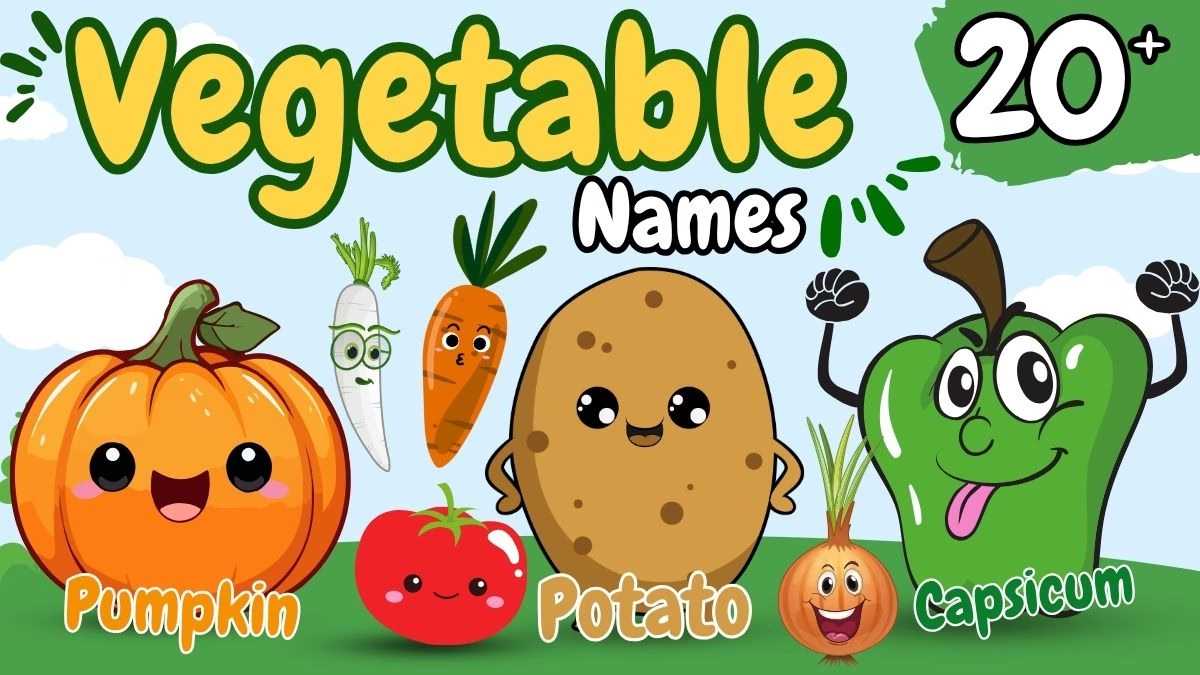Learning vegetable names in English for kids is not only fun but also very important for early learning. When children start recognizing different vegetables name in English, they build strong vocabulary skills and get curious about the food they eat. From carrots to cabbages, spinach to sweet potatoes, knowing 20 vegetables name or even A to Z vegetables name in English makes learning exciting!
For young learners, especially in preschool or primary classes, colorful vegetables can be both a source of learning and joy. Imagine your child pointing to a tomato and confidently saying, “This is a tomato!” That’s the magic of learning vegetable names for kids in English with pictures. It creates a strong connection between words and real-life objects.
In India, teaching Indian vegetable names for kids in English is a great way to introduce them to both local foods and global language. Vegetables like brinjal (eggplant), ladyfinger (okra), and bitter gourd become easier to identify and name. This not only makes kids more aware of what’s on their plate but also builds healthy habits from a young age.
Whether you’re teaching 20 vegetables name in English, making a vegetables name list, or exploring an A to Z vegetables name in English chart, this fun journey helps children understand nature, nutrition, and language together. So let’s dive into this colorful and tasty world of vegetable names in English for kids — with pictures, fun facts, and simple words that will make learning enjoyable for every little explorer!
Read More: Wild Animals Name and Domestic Animals List Every Kid Should Know
What Are Vegetables and Why Are They Important?
Vegetables are parts of plants that we eat. These can be roots like carrots, leaves like spinach, stems like celery, or even flowers like broccoli. These vegetables have many colors, shapes, and sizes, and they’re very healthy! Learning about vegetable names in English for kids is a great way to start understanding what we eat and why it’s good for us.
When kids learn the vegetables name in English, they not only grow their vocabulary but also start recognizing the healthy foods on their plate. From knowing 20 vegetables name in English like potato, onion, capsicum, to learning with vegetable names for kids in English with pictures, it becomes a fun and tasty adventure.
Why Are Vegetables So Important for Kids?
-
Full of Good Stuff: Vegetables are rich in vitamins and minerals like Vitamin A, Vitamin C, iron, and calcium, which help children grow strong and smart.
-
Keep Tummy Happy: The fiber in vegetables helps in smooth digestion and keeps your stomach clean and healthy.
-
Stronger Immunity: Eating a mix of colorful veggies every day makes your body better at fighting off sickness.
-
Bright Eyes and Clear Skin: Vegetables like carrots and tomatoes help keep your eyes sharp and your skin glowing!
For Indian families, teaching Indian vegetable names for kids in English like brinjal (eggplant), ladyfinger (okra), and bottle gourd makes learning even more relatable. Whether you’re exploring an A to Z vegetables name in English list or just starting with 20 vegetables name, it’s a fun way to connect learning with daily life. So, let’s explore the exciting world of vegetable names in English for kids—with colors, fun facts, and pictures that make every meal a learning moment!
Why Should Young Kids Know About Vegetables?
Teaching vegetable names in English for kids is more than just helping them remember a few words. It’s about giving them the tools to make healthier choices, become more aware of their surroundings, and grow into curious, confident learners. When children start learning vegetables name in English at a young age, it lays the foundation for a lifetime of good habits.
- Encourages Healthy Eating Habits: When kids can name the vegetables they see on their plate, like carrot, spinach, or peas, they’re more likely to eat them. Familiarity builds interest. Using fun tools like vegetable names for kids in English with pictures can turn mealtime into a learning adventure instead of a struggle.
- Boosts Language and Communication Skills: Learning the vegetable names in English for kids also expands their vocabulary. It helps them describe what they see, feel, and eat. For example, saying “I like crunchy cucumbers” or “Green beans are my favorite” becomes part of their daily language practice.
- Promotes Cultural Awareness and Curiosity: Exploring Indian vegetable names for kids in English, like bottle gourd, bitter gourd, or drumstick, introduces children to the rich variety of foods from different regions. When they hear that eggplant is called brinjal in India, or zucchini is used in Italian cooking, it sparks interest in global cultures and cuisines.
- Creates a Bond with Nature: Knowing that vegetables grow from the soil—some underground like potatoes, and some on vines like tomatoes—helps children connect with the environment. It teaches them how food is grown and why protecting nature is important.
Whether you’re introducing 20 vegetables name in English, exploring an A to Z vegetables name in English chart, or just identifying everyday items in the kitchen, learning vegetable names in English for kids builds knowledge, confidence, and curiosity—one veggie at a time!
Visit our channel: Vegetable Names for Kids | Learn Vegetable Names with Pictures and Pronunciation
Vegetable Names for Kids in English – Definitions and Interesting Facts
Brinjal (Eggplant)
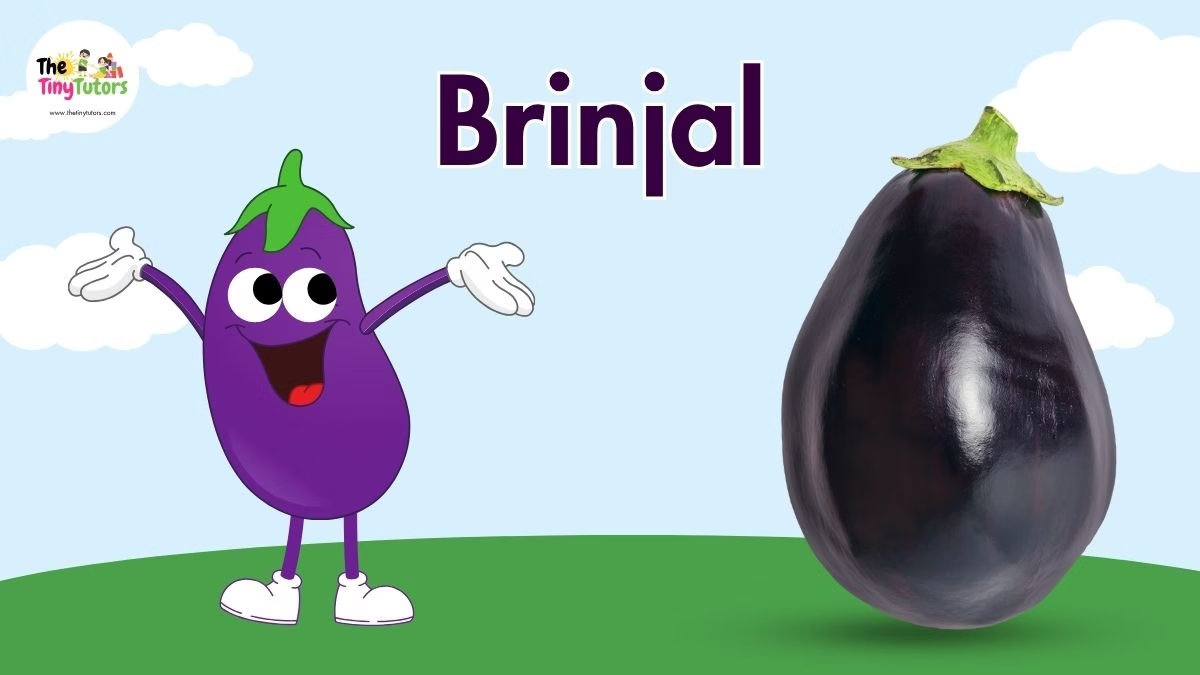
Definition: Brinjal is a long purple vegetable that is soft when cooked and used in many dishes.
Interesting Fact: Brinjals come in many colors like purple, white, and green!
Capsicum (Bell Pepper)
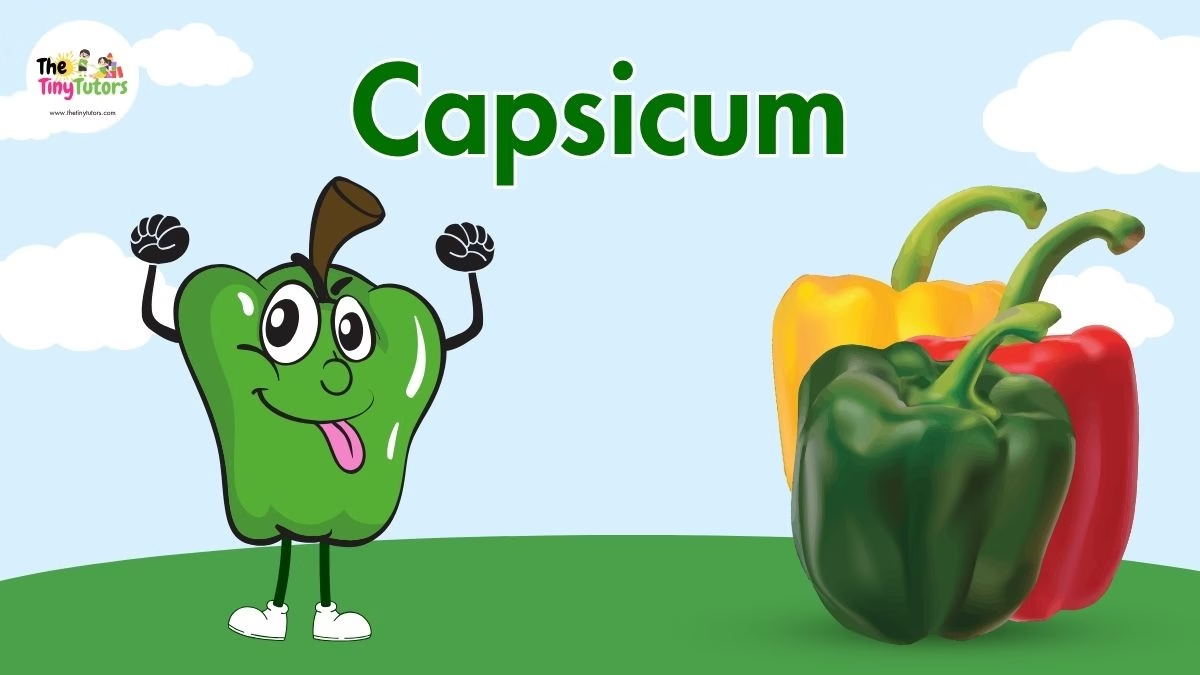
Definition: Capsicum is a crunchy and colorful vegetable that comes in bright red, green, and yellow colors. It is not only tasty but also full of vitamins that help keep our bodies strong and healthy. Learning vegetable names in English for kids like capsicum is fun because it teaches them about healthy foods that add color and nutrition to their meals. Capsicum can be eaten raw in salads or cooked in many delicious dishes, making it a favorite vegetable for kids to enjoy!
Interesting Fact: Capsicums have lots of vitamin C, which helps keep us healthy!
Carrot
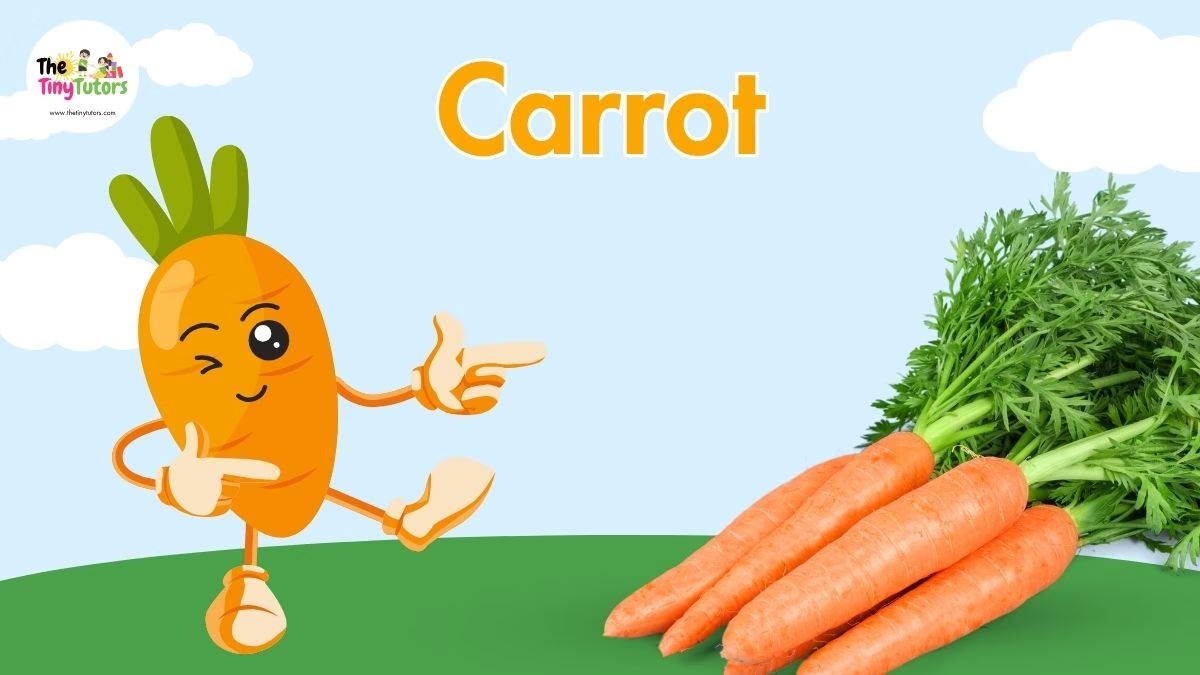
Definition: Carrot is a bright orange root vegetable that grows underground and tastes sweet and crunchy. It’s a favorite among many kids because it can be eaten raw as a healthy snack or cooked in different dishes like soups and stews. When kids learn vegetable names in English for kids, carrot is always one of the first vegetables they discover because it’s easy to recognize and very good for their eyes and overall health. Carrots are packed with a special nutrient called beta-carotene, which helps keep our eyesight sharp and our bodies strong!
Interesting Fact: Carrots have something called beta-carotene that helps keep our eyes healthy!
Cauliflower
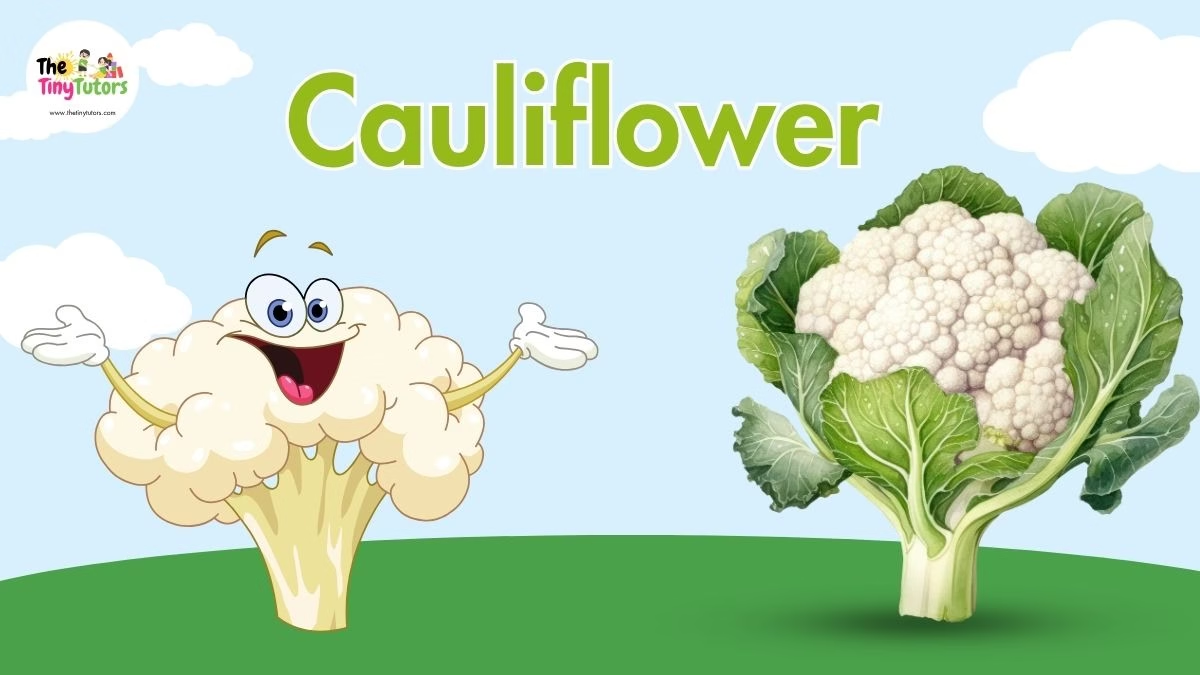
Definition: Cauliflower looks like a white flower and is very healthy to eat cooked or raw.
Interesting Fact: Cauliflower is related to broccoli, but cauliflower is white and broccoli is green.
Lady Finger (Okra)
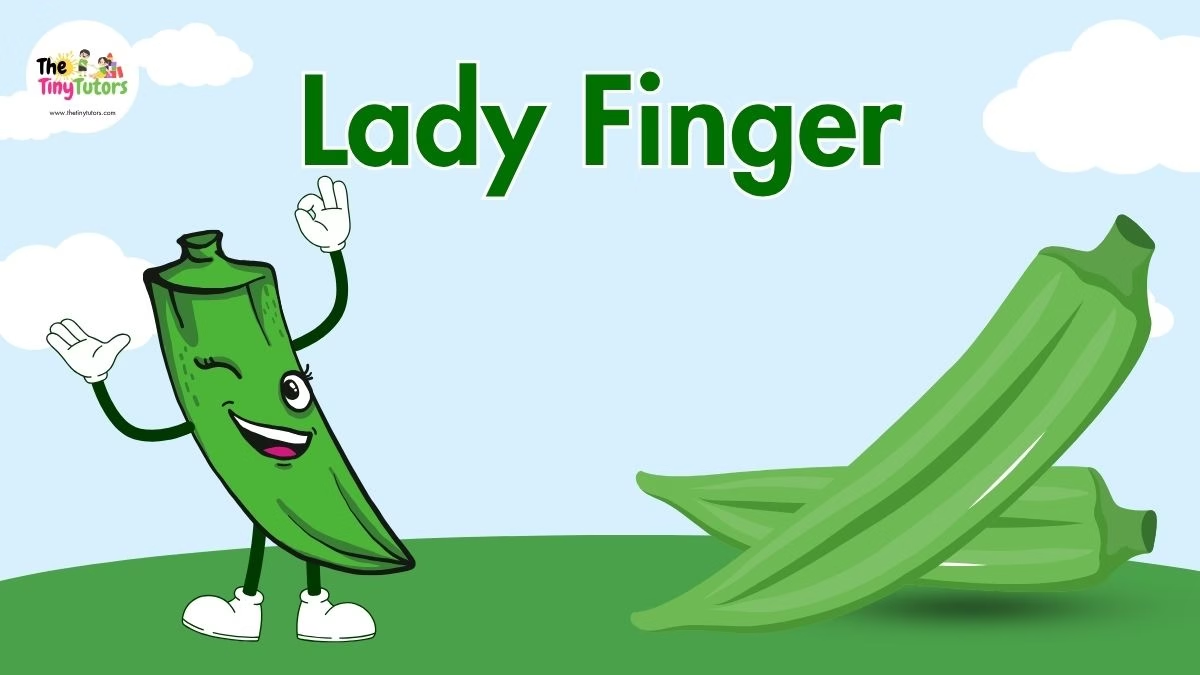
Definition: Lady Finger is a long, green vegetable that is a bit sticky inside and is used in many dishes.
Interesting Fact: The sticky juice in lady finger helps thicken soups and curries!
Onion
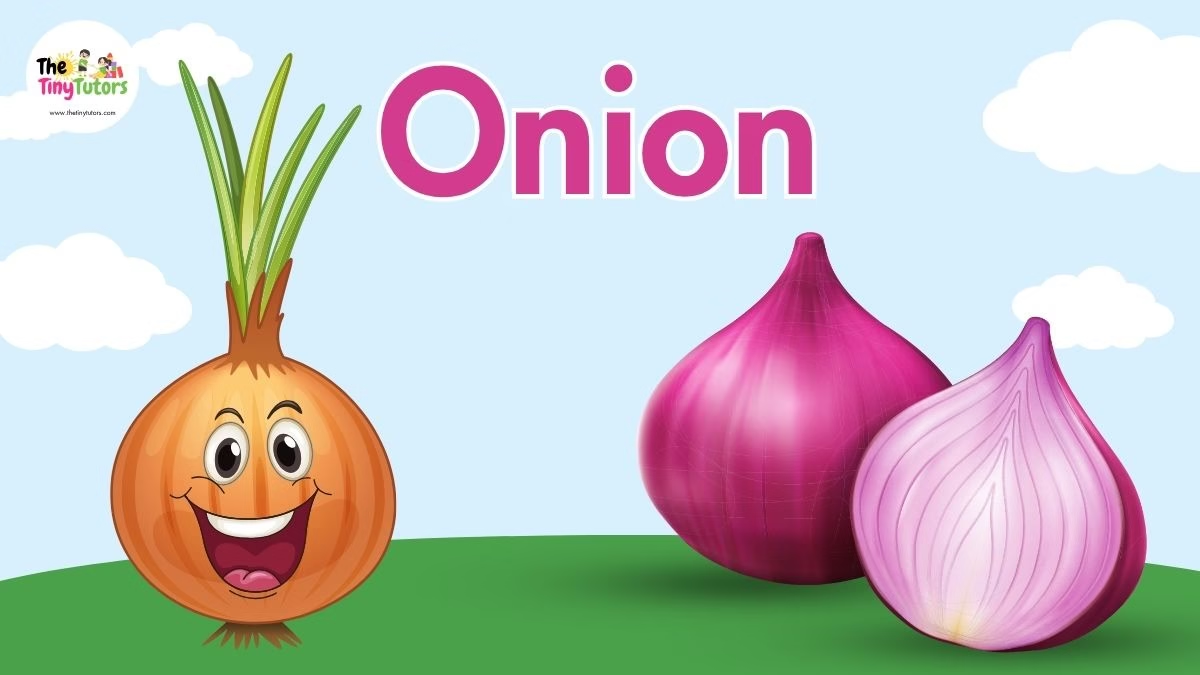
Definition: Onion is a round vegetable that makes food taste delicious but can make your eyes water when you cut it!
Interesting Fact: Onions have a special chemical that makes your eyes tear up when you chop them.
Potato
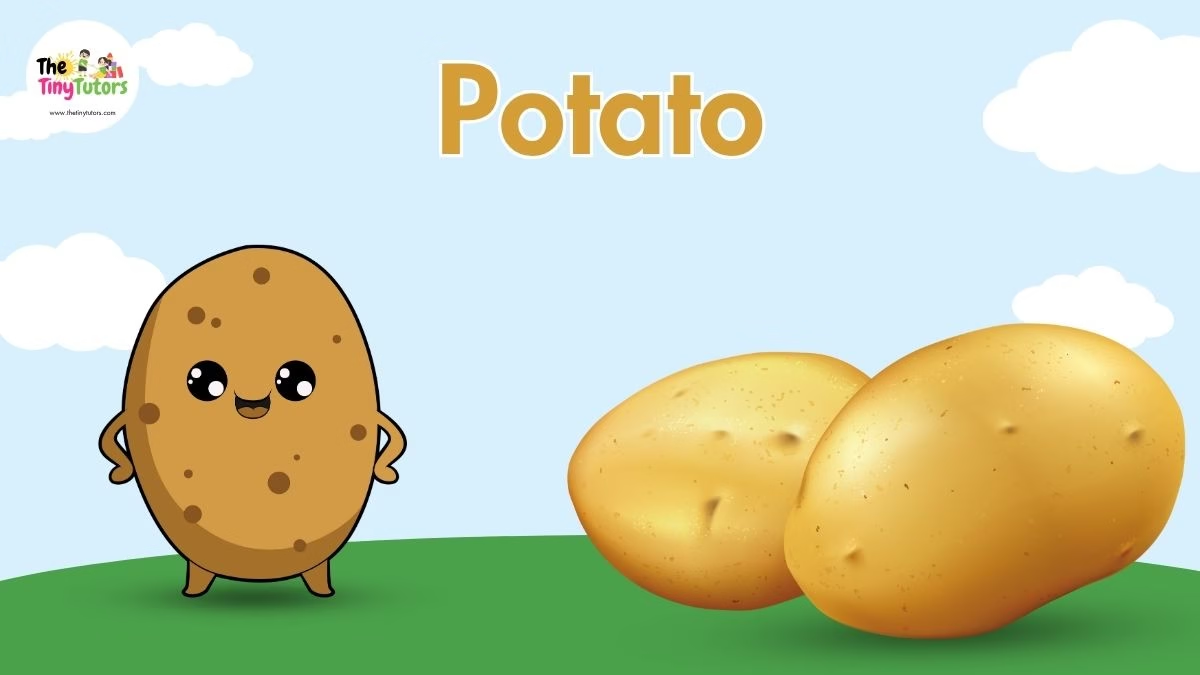
Definition: Potato is a starchy vegetable that grows underground and can be cooked in many ways like fries or mash.
Interesting Fact: Potato is one of the most popular vegetables around the world, and while learning vegetable names in English for kids, it’s exciting to know that potatoes are among the top four crops grown globally!
Tomato
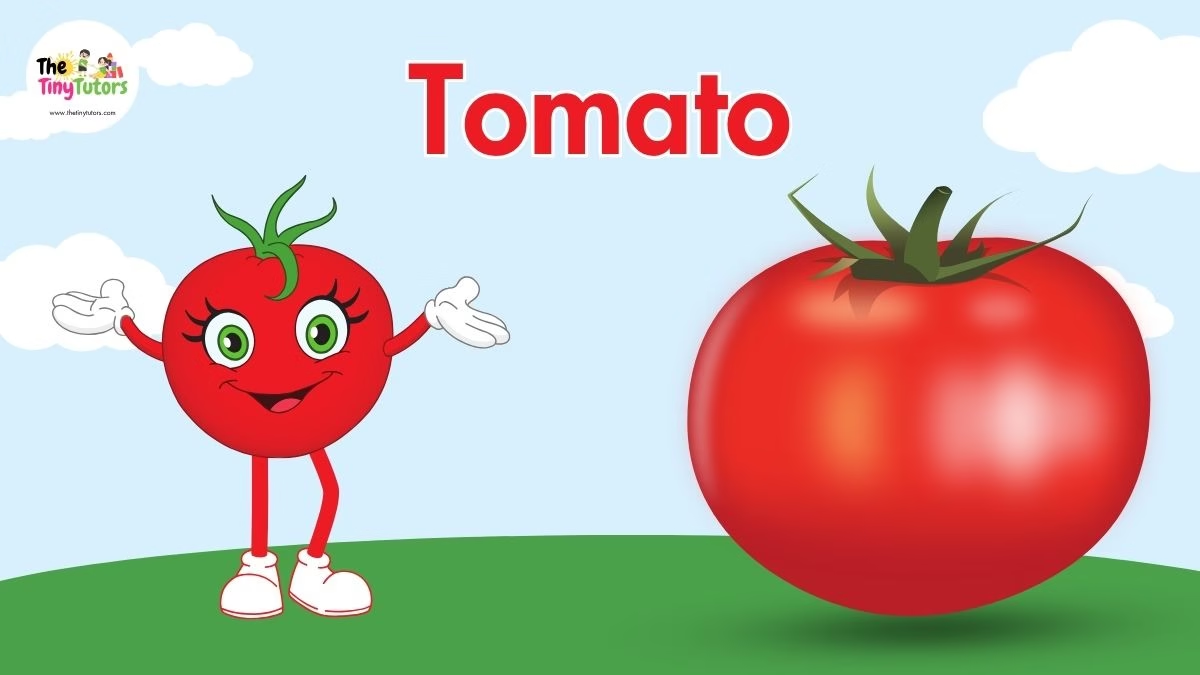
Definition: Tomato is a soft, red fruit that tastes juicy and is used like a vegetable in many dishes. While exploring vegetable names in English for kids, tomato is a fun one because it looks like a veggie but is actually a fruit!
Interesting Fact: Tomato is actually a fruit but is used as a vegetable in cooking.
Cucumber
Definition: Cucumber is a long, green, and watery vegetable often eaten raw in salads.
Interesting Fact: Cucumbers are 95% water and help keep you hydrated!
Spinach
Definition: Spinach is a leafy green vegetable full of iron and very good for your health.
Interesting Fact: Spinach helps make your blood strong because it has lots of iron.
Peas
Definition: Peas are small, round green seeds that grow inside pods.
Interesting Fact:
Peas are tiny, green, round vegetables often called “little green balls.” When learning vegetable names in English for kids, peas are a fun and healthy veggie to know!
Cabbage
Definition: Cabbage is a leafy vegetable that grows in a round shape and can be green or purple.
Interesting Fact: Cabbage can be eaten raw, cooked, or even made into pickles!
Broccoli
Definition: Broccoli looks like a little green tree and is very healthy.
Interesting Fact: Broccoli is full of vitamin C and fiber, which helps your tummy feel good.
Pumpkin
Definition: Pumpkin is a big, round, orange vegetable that is used in delicious dishes and for festive decorations. It’s a favorite when learning vegetable names in English for kids because it’s both yummy and fun to carve!
Interesting Fact: Pumpkin seeds are tasty snacks and very healthy too!
Sweet Potato
Definition: Sweet Potato is a yummy, orange root vegetable that grows underground. When learning vegetable names in English for kids, sweet potato is a tasty and healthy choice that’s full of vitamins and energy!
Interesting Fact: Sweet potatoes have more fiber and vitamin A than regular potatoes!
Radish
Definition: Radish is a small root vegetable that can be red, white, or pink and tastes a little spicy.
Interesting Fact: Radishes come in many colors and can add a crunchy spice to salads.
Turnip
Definition: Turnip is a round, white or purple root vegetable with a mild taste.
Interesting Fact: Turnips have been eaten for thousands of years and are very healthy!
Zucchini
Definition: Zucchini is a soft, green vegetable that looks like a cucumber and is used in many cooked dishes. It’s a fun one to spot while learning vegetable names in English for kids because of its simple shape and mild taste!
Interesting Fact: Zucchini is also called “courgette” in some countries.
Artichoke
Definition: Artichoke is a green, spiky vegetable whose heart is delicious to eat.
Interesting Fact: When learning vegetable names in English for kids, it’s fun to know that the soft middle part of an artichoke, called the heart, is the yummiest to eat!
Asparagus
Definition: Asparagus is a tall, thin green vegetable that tastes special and grows fast.
Interesting Fact: Some asparagus can grow up to 6 inches in just one day!
Different Types of Vegetables
Vegetables come in all shapes, sizes, and colors! They grow on plants, and we eat different parts of those plants. Isn’t that cool? When learning vegetable names in English for kids, it’s also fun to know how and where these vegetables grow. Let’s explore the different types of vegetables based on the part of the plant we eat.
Root Vegetables
These vegetables grow under the ground. It’s the root of the plant that we eat. Roots store energy and help the plant stay strong.
Examples:
-
Carrot
-
Beetroot
-
Radish
Fun Fact: Carrots are not only orange—they can be purple, red, yellow, or even white!
When kids learn vegetable names in English for kids, root vegetables like carrots and radishes are easy to remember because they’re crunchy and colorful!
Leafy Vegetables
These are vegetables where the leaves are the part we eat. They are super healthy and full of vitamins like A, C, and K, as well as minerals like iron and calcium.
Examples:
-
Spinach
-
Cabbage
-
Lettuce
Tip: Leafy greens help kids grow strong bones, boost the immune system, and keep the body active.
In most beginner lists of vegetable names in English for kids, leafy greens are always included because they are very common and easy to spot in meals.
Fruit Vegetables
Yes, some vegetables are actually fruits! These grow from the flower of the plant and have seeds inside.
Examples:
-
Tomato
-
Cucumber
-
Pumpkin
Did You Know? Tomato is a fruit in science, but in the kitchen, it’s used like a vegetable!
While exploring vegetable names in English for kids, this type surprises many children because the line between fruit and vegetable can be confusing—and fun to learn about!
Flower Vegetables
These are the edible flowers of a plant. Sometimes, we eat them before they bloom; sometimes, when they are in full bloom.
Examples:
-
Cauliflower
-
Broccoli
Interesting: Broccoli looks like a tiny green tree—and it’s full of fiber and vitamin C!
Learning vegetable names in English for kids becomes exciting with fun shapes like broccoli and cauliflower!
Stem Vegetables
These vegetables come from the plant’s stalk or stem. They carry water and nutrients from the roots to the leaves and fruits..
Examples:
-
Ladyfinger (Okra)
-
Celery
-
Asparagus
Fun Fact: Ladyfinger is also called “okra” and gets its name because it looks like a finger!
When kids are introduced to vegetable names in English for kids, stem vegetables like okra are fun to learn because of their unique shape and name.

